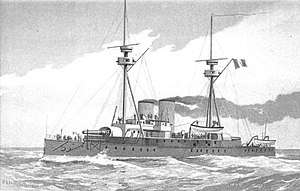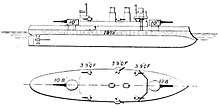French ironclad Terrible
Terrible was an ironclad barbette ship built for the French Navy in the late 1870s and early 1880s. She was the lead ship of the Terrible class, which included three other vessels. They were built as part of a fleet plan started in 1872, which by the late 1870s had been directed against a strengthening Italian fleet. The ships were intended for coastal operations, and as such had a shallow draft and a low freeboard, which greatly hampered their seakeeping and thus reduced their ability to be usefully employed after entering service. Armament consisted of a pair of 420 mm (16.5 in) guns in individual barbettes, the largest gun ever mounted on a French capital ship. Terrible was laid down in 1877 and was completed in 1887.
.jpg) | |
| History | |
|---|---|
| Name: | Terrible |
| Laid down: | December 1877 |
| Launched: | 1881 |
| Commissioned: | January 1887 |
| Struck: | 1911 |
| Fate: | Broken up |
| General characteristics | |
| Displacement: | 7,530 long tons (7,650 t) |
| Length: | 82.75 m (271 ft 6 in) pp |
| Beam: | 17.98 m (59 ft) |
| Draft: | 7.98 m (26 ft 2 in) |
| Installed power: |
|
| Propulsion: |
|
| Speed: | 14.5 to 15 kn (26.9 to 27.8 km/h; 16.7 to 17.3 mph) |
| Complement: | 373 |
| Armament: |
|
| Armor: |
|
Due to their handling problems, Terrible and her sister ships saw little active service with the French fleet, instead spending most of their careers in the Reserve Squadron of the Mediterranean Fleet. During this period, the ship spent most of the year out of service with reduced crews, only being reactivated for the fleet maneuvers each year. She was modernized in 1898 with new guns, but by this time, numerous, more effective pre-dreadnought battleships had been built. These ships displaced Terrible and her sisters in the Reserve Squadron, and she was ultimately stricken from the naval register in 1911 and thereafter broken up.
Design

The Terrible class of barbette ships was designed in the late 1870s as part of a naval construction program that began under the post-Franco-Prussian War fleet plan of 1872. By 1877, the Italian fleet under Benedetto Brin had begun building powerful new ironclads of the Caio Duilio and Italia classes, which demanded a French response, beginning with the ironclad Amiral Duperré of 1877. In addition, the oldest generation of French ironclads, built in the early-to-mid 1860s, were in poor condition and necessitated replacement. The Terrible class was intended to replace old monitors that had been built for coastal defense. Ships of the class were based on the Amiral Baudin-class ironclads, but reduced in size to allow them to operate in shallower waters.[1]
Terrible was 82.75 m (271 ft 6 in) long between perpendiculars, with a beam of 17.98 m (59 ft) and a draft of 7.98 m (26 ft 2 in). The vessel displaced 7,530 long tons (7,650 t) and had a relatively low freeboard. She was fitted with a pair of pole masts equipped with spotting tops for her main battery guns. Her propulsion machinery consisted of two compound steam engines with steam provided by twelve coal-burning fire-tube boilers. The engines were rated to produce 6,500 indicated horsepower (4,800 kW) for a top speed of 14.5 to 15 knots (26.9 to 27.8 km/h; 16.7 to 17.3 mph). The ship's crew consisted of 373 officers and enlisted men.[2]
Her main armament consisted of two 420 mm (16.5 in) guns, one forward and one aft, mounted on the centerline in barbettes. These weapons were normally 22-caliber, but those mounted on Terrible had to be shortened to 19.3 calibers after initial testing revealed cracks at the muzzle.[2] They were the largest-bore guns ever carried by a French capital ship.[3] These were supported by a secondary battery of four 100 mm (3.9 in) guns carried in individual pivot mounts with gun shields. For defense against torpedo boats, she carried two or four 47 mm (1.9 in) 3-pounder Hotchkiss revolver cannon and sixteen 37 mm (1.5 in) 1-pounder Hotchkiss revolvers, all in individual mounts. Her armament was rounded out with four 356 mm (14 in) torpedo tubes.[2]
The ship was protected with mild steel armor; her belt was 203 to 508 mm (8 to 20 in) thick and extended for the entire length of the hull. At even normal loading, the belt was nearly submerged entirely, reducing its effectiveness significantly. The barbettes for the main battery were 457 mm (18 in) thick and the tubular supports connecting them to the ammunition magazines were 203 mm. Her conning tower armor was 25 mm (0.98 in) thick, as were the shields for the 100 mm guns.[2]
1898 modifications
Terrible was modernized in 1898, having her old 420 mm guns replaced with two 35-caliber 340 mm (13.4 in) Modèle 1893 guns. Her secondary battery of 100 mm guns was replaced with a quick-firing version of the weapon, with an additional pair being installed. The light battery was also revised to fourteen 47 mm guns. Two of her torpedo tubes were also removed. As a result of these changes, her crew was reduced to 332 officers and men.[2]
Service history

Terrible was laid down in December 1877 in Brest, France, launched in 1881 and completed in January 1887.[2] After entering service, the Terrible-class ships were found to have very poor seakeeping as a result of their shallow draft and insufficient freeboard, even in the relatively sheltered waters of the Mediterranean Sea. The Navy had little use for the ships, and through the 1880s and 1890s, a series of French naval ministers sought to find a role for the vessels, along with another ten coastal-defense type ironclads built during that period. The ships frequently alternated between the Mediterranean Squadron and the Northern Squadron, the latter stationed in the English Channel, but neither location suited their poor handling.[4] Terrible was activated on 23 August 1888 for the annual fleet maneuvers, though she was delayed somewhat by a shortage of propellant charges for her guns. The fleet had assembled at Hyères by 30 August and the maneuvers ended on 4 September, with the fleet returning to Toulon by the 10th.[5]
By the early 1890s, Terrible and her sister ships had been reduced to the Reserve Squadron of the Mediterranean Fleet, which was based in Toulon. During this period, the ships were maintained in a state of inactivity with half or two-thirds of their normal crews, only being mobilized for the annual training maneuvers with the rest of the fleet.[6] During the fleet maneuvers of 1891, which began on 23 June, Terrible was mobilized along with her sisters Caïman and Indomptable and five other ironclads. The reserve ships took several days to ready themselves for the exercises before they were able to join the rest of the fleet by 6 July, the maneuvers lasting another five days thereafter.[7] Terrible served with the Reserve Squadron of the Mediterranean Fleet in 1893; at that time, the squadron also included Caïman and Indomptable and the ironclads Colbert, Friedland, Richelieu, Redoutable, and Trident.[8]

In 1894, Terrible had been assigned to the 1st Division, Reserve Squadron, along with Caïman and Richelieu. She served in the fleet maneuvers in the Mediterranean that year, which included an initial period of exercises from 1 to 10 July and then larger-scale maneuvers from 17 to 28 July.[9] She remained in the squadron the following year, by which time Indomptable and the ironclad Amiral Duperré had joined her.[10] In 1896, the Reserve Squadron consisted of Amiral Duperré, the flagship, Caïman, Terrible, and Trident.[6] By the following year, the unit was again revised, now consisting of Caïman, Terrible, Amiral Duperré, and the ironclads Friedland and Dévastation.[11]
The ship was modernized in 1898 with new main and secondary guns and two of her torpedo tubes removed.[2] She returned to service with the Reserve Squadron later that year, which by this time consisted of Caïman and the ironclads Amiral-Tréhouart, Bouvines, Jemmapes, and Valmy.[12] The following year, the reserve squadron was again reorganized, now consisting of a division of the sea-going ironclads Marceau, Neptune, and Courbet and a division of coastal ironclads led by Terrible and including Furieux, Tonnant, and Vengeur. The squadron was not activated for the annual fleet maneuvers that year.[13]
Terrible was the only member of her class available for the Reserve Squadron by 1901, as her sisters were still out of service, undergoing their reconstructions. Since a number of older vessels were being rebuilt at that time, the only other capital ship in the squadron was the ironclad Magenta.[14] The next year, she was laid up out of service.[15] By 1903, all four of the Terrible-class ironclads had been removed from service, their place in the Reserve Squadron having been taken by the pre-dreadnought battleships that had been built in the 1890s.[16] Terrible was stricken from the naval register in 1911 and subsequently sold for scrap.[2] Her two 340 mm guns were retained in storage and were later converted into railway guns during World War I in 1916 and delivered to the French Army in November 1917.[17]
Notes
- Ropp, pp. 92, 97–98.
- Gardiner, p. 291.
- Ropp, p. 99.
- Ropp, p. 180.
- Brassey 1889, pp. 450–451.
- Weyl, p. 95.
- Thursfield 1892, pp. 61–67.
- Brassey 1893, p. 70.
- Thursfield 1894, pp. 72–77.
- Brassey 1895, p. 50.
- Brassey 1897, p. 57.
- Brassey 1899, p. 70.
- Jordan & Caresse, pp. 217–218.
- Leyland, p. 72.
- Brassey 1902, p. 48.
- Jordan & Caresse, p. 223.
- Friedman, p. 207.
References
- Brassey, Thomas (1889). "French Naval Manoeuvres, 1888". The Naval Annual. Portsmouth: J. Griffin & Co.: 230. OCLC 496786828.
- Brassey, Thomas A. (1893). "Chapter IV: Relative Strength". The Naval Annual. Portsmouth: J. Griffin & Co.: 66–73. OCLC 496786828.
- Brassey, Thomas A. (1895). "Chapter III: Relative Strength". The Naval Annual. Portsmouth: J. Griffin & Co.: 49–59. OCLC 496786828.
- Brassey, Thomas A. (1897). "Chapter III: Relative Strength". The Naval Annual. Portsmouth: J. Griffin & Co.: 56–77. OCLC 496786828.
- Brassey, Thomas A. (1899). "Chapter III: Relative Strength". The Naval Annual. Portsmouth: J. Griffin & Co.: 70–80. OCLC 496786828.
- Brassey, Thomas A. (1902). "Chapter III: Relative Strength". The Naval Annual. Portsmouth: J. Griffin & Co.: 47–55. OCLC 496786828.
- Friedman, Norman (2011). Naval Weapons of World War One. Annapolis: Naval Institute Press. ISBN 978-1-84832-100-7.
- Gardiner, Robert, ed. (1979). Conway's All the World's Fighting Ships 1860–1905. London: Conway Maritime Press. ISBN 978-0-85177-133-5.
- Jordan, John & Caresse, Philippe (2017). French Battleships of World War One. Annapolis: Naval Institute Press. ISBN 978-1-59114-639-1.
- Leyland, John (1901). Brassey, Thomas A. (ed.). "Chapter IV: Comparative Strength". The Naval Annual. Portsmouth: J. Griffin & Co.: 71–79. OCLC 496786828.
- Ropp, Theodore (1987). Roberts, Stephen S. (ed.). The Development of a Modern Navy: French Naval Policy, 1871–1904. Annapolis: Naval Institute Press. ISBN 978-0-87021-141-6.
- Thursfield, J. R. (1892). "Foreign Naval Manoeuvres". The Naval Annual. Portsmouth: J. Griffin & Co.: 61–88.
- Thursfield, J. R. (1894). Brassey, Thomas A. (ed.). "Foreign Maneouvres: I—France". The Naval Annual. Portsmouth: J. Griffin & Co.: 71–102. OCLC 496786828.
- Weyl, E. (1896). Brassey, Thomas A. (ed.). "Chapter IV: The French Navy". The Naval Annual. Portsmouth: J. Griffin & Co.: 61–72. OCLC 496786828.